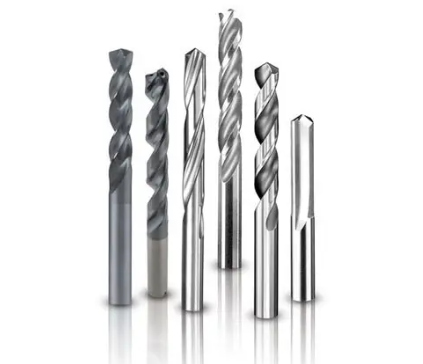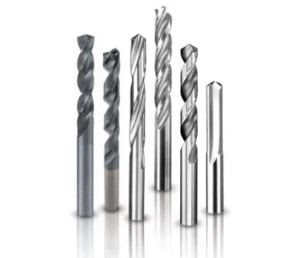Our Location
304 North Cardinal St.
Dorchester Center, MA 02124

Carbide Drill Processing Parameter Table
Carbide drills are widely applied in industrial machining because of their excellent hardness, wear resistance, and ability to withstand high-speed cutting environments. Unlike high-speed steel drills, carbide drill bits can maintain their sharpness and performance even under extreme thermal conditions, making them indispensable in automotive, aerospace, mold making, and precision engineering industries. When using carbide drills, one of the most important considerations is the correct selection of processing parameters such as cutting speed, feed rate, drilling depth, coolant usage, and retraction method. These parameters directly influence tool life, surface finish, and machining efficiency. If the parameters are set too aggressively, carbide drills may chip or break due to their brittle nature, while overly conservative parameters may lead to reduced efficiency and higher production costs. Therefore, manufacturers and engineers rely on detailed carbide drill processing parameter tables provided by leading brands like Sandvik Coromant, Kennametal, Mitsubishi Materials, OSG, Walter, Seco, Guhring, and Sumitomo to optimize machining performance.
Importance of Processing Parameters in Carbide Drilling
Carbide drills differ significantly from conventional drills because they require precise control of cutting forces. Processing parameters such as cutting speed (Vc, m/min), feed per revolution (fn, mm/rev), and drilling depth-to-diameter ratio (L/D) determine whether the drill operates smoothly or fails prematurely. For example, when drilling hardened steel (HRC 55+), carbide drills may run at cutting speeds of 50–120 m/min, whereas HSS drills would only handle 10–20 m/min under similar conditions. Similarly, feed rates for carbide drills are often higher to allow efficient chip evacuation, with values ranging from 0.05 mm/rev for small diameters up to 0.25 mm/rev for larger diameters. Coolant is another critical factor because it reduces heat accumulation and helps flush out chips, preventing re-cutting that can damage cutting edges. Without adhering to proper parameter guidelines, even the best carbide drills may fail prematurely.
General Carbide Drill Processing Parameter Table
Below is a general table of recommended carbide drill parameters, which may vary slightly depending on the brand, drill model, and specific workpiece material.
Mild Steel (≤ 200 HB): Cutting speed 100–160 m/min, Feed rate 0.08–0.22 mm/rev, Coolant recommended.
Alloy Steel (200–300 HB): Cutting speed 80–140 m/min, Feed rate 0.08–0.20 mm/rev, Coolant strongly recommended.
Stainless Steel (Austenitic, Ferritic): Cutting speed 60–120 m/min, Feed rate 0.05–0.18 mm/rev, High coolant pressure essential.
Hardened Steel (HRC 50–60): Cutting speed 50–120 m/min, Feed rate 0.05–0.15 mm/rev, Internal coolant highly recommended.
Cast Iron (Gray/SG Iron): Cutting speed 90–150 m/min, Feed rate 0.08–0.25 mm/rev, Dry or minimal coolant acceptable.
Aluminum and Alloys: Cutting speed 200–300 m/min, Feed rate 0.12–0.30 mm/rev, Coolant optional depending on tool coating.
Titanium Alloys: Cutting speed 40–80 m/min, Feed rate 0.05–0.15 mm/rev, Copious coolant essential due to heat sensitivity.
Superalloys (Inconel, Hastelloy): Cutting speed 20–60 m/min, Feed rate 0.05–0.12 mm/rev, Internal high-pressure coolant required.
These values are general guidelines and actual machining conditions must be adjusted based on tool manufacturer recommendations, workpiece clamping, machine rigidity, and tool length.

Brand-Specific Carbide Drill Processing Parameters
Different brands provide detailed cutting parameter charts tailored to their carbide drill models. For instance, Sandvik Coromant CoroDrill® 860 series specifies higher feed rates for deep-hole drilling in stainless steels, while Kennametal Kenna Universal Drill™ provides optimized parameters for aerospace alloys. Mitsubishi Materials MVE and MVS series carbide drills emphasize internal coolant channels and recommend cutting speeds of 70–120 m/min for titanium alloys, while Walter Titex Xtreme Evo drill series provides guidelines of up to 160 m/min for cast iron applications. Guhring RT 100 XF series drills are designed for high-performance drilling in hardened steels, allowing speeds of 80–130 m/min with coated versions. Seco Perfomax carbide drills are optimized for automotive aluminum components and run at speeds exceeding 250 m/min. OSG ADO-TRS carbide drills highlight triple-margin design for stable titanium machining, recommending speeds between 40–70 m/min depending on diameter.
Example Brand and Model Parameter Recommendations
Sandvik Coromant CoroDrill® 860-GM: Designed for general applications, recommended cutting speeds are 80–160 m/min for steels, 60–120 m/min for stainless steels, and up to 250 m/min for aluminum alloys. Feed per revolution varies between 0.05–0.25 mm/rev.
Kennametal KSEM™ Modular Drills: Allow for drilling of alloy steels at 100–140 m/min with feeds of 0.12–0.20 mm/rev, with coolant pressure of 20–30 bar.
Mitsubishi Materials MVS Series: For stainless steels, cutting speeds are recommended at 60–110 m/min with feeds of 0.08–0.20 mm/rev, while titanium alloys require 40–70 m/min with heavy coolant.
Walter Titex Xtreme Evo: For cast iron, cutting speeds range 120–160 m/min with feed rates of 0.10–0.25 mm/rev, dry machining allowed.
OSG ADO-TRS: Titanium alloys require cutting speeds of 40–70 m/min and feed rates of 0.05–0.12 mm/rev with internal coolant above 30 bar.
Guhring RT 100 XF: Hardened steels (HRC 50–60) can be drilled at 80–120 m/min with feeds of 0.05–0.15 mm/rev using high-pressure coolant.
Seco Perfomax Carbide Drills: Aluminum alloys processed at 200–300 m/min with feed rates of 0.12–0.30 mm/rev, coolant optional.
Sumitomo SMD Drill Series: Nickel alloys require 25–60 m/min cutting speed and feeds of 0.05–0.10 mm/rev with internal coolant above 40 bar.
Coolant and Chip Evacuation Considerations
Carbide drills often fail not due to tool wear alone but because of poor chip evacuation. When drilling deep holes (greater than 5×D), coolant-through carbide drills with high-pressure pumps (20–70 bar depending on the application) are essential. Brands like Sandvik, Mitsubishi, and OSG specifically design drills with polished flutes and internal coolant channels to enhance chip evacuation. For example, OSG’s ADO series and Mitsubishi’s MVE series use double-margin or triple-margin geometry for stability and smoother chip flow. For materials such as titanium and Inconel, high-pressure coolant not only flushes chips but also reduces heat, preventing work hardening.
Surface Finish and Tool Life Optimization
When processing parameters are properly set according to the manufacturer’s tables, carbide drills can produce superior surface finishes with round, burr-free holes. For instance, Walter’s Xtreme Evo drills are capable of producing H8 tolerance holes in steels and cast iron. To extend tool life, coating technology such as TiAlN, AlCrN, or diamond-like carbon coatings is often applied, and parameter tables usually differentiate recommended values between coated and uncoated drills. Guhring, for example, publishes separate cutting data for their NanoFire and NanoA coating series, which allow higher speeds by 15–25% compared to uncoated versions.
Conclusion on Carbide Drill Parameter Tables
Carbide drill processing parameter tables serve as indispensable guidelines for engineers and machinists seeking efficiency, productivity, and precision. They help select the right balance of cutting speed, feed rate, and coolant strategy to maximize tool life and ensure reliable performance. Leading brands such as Sandvik Coromant, Kennametal, Mitsubishi Materials, OSG, Walter, Guhring, Seco, and Sumitomo provide comprehensive charts tailored to their drill models and coating technologies. By carefully following these recommendations, users can achieve optimal hole quality, minimize tool costs, and enhance production throughput across various industries ranging from automotive to aerospace.